Why Is My Gecko’s Poop Black and White? [With Science]
Have you ever thought about why your gecko’s poop has the characteristic black and white parts to it? Have you panicked at the thought of a sick pet? Or is having a black and white waste matter typical for reptiles? If the droppings are not in black and white, you should raise your attention in caring for your gecko!
Geckos have a single orifice for excreting urine and feces. They expel urates as white uric acid crystals found at the black wastes’ tip to conserve water. An excreta that features any of the following: pure black, white, or green indicate the presence of insects, worms, or sand; or soft stool.
Keep on scrolling to understand more about your gecko’s poop!
What Makes Gecko Excrete a Black and White Poop?
Though we are typically used to observing liquid urine and solid feces from our cats and dogs, you might have found it strange that you were only cleaning after solid excrement in your gecko’s tank for quite some time. But you should not panic. It turns out that this is normal for geckos and their reptile cousins. After all, we have different biology going on in our bodies.
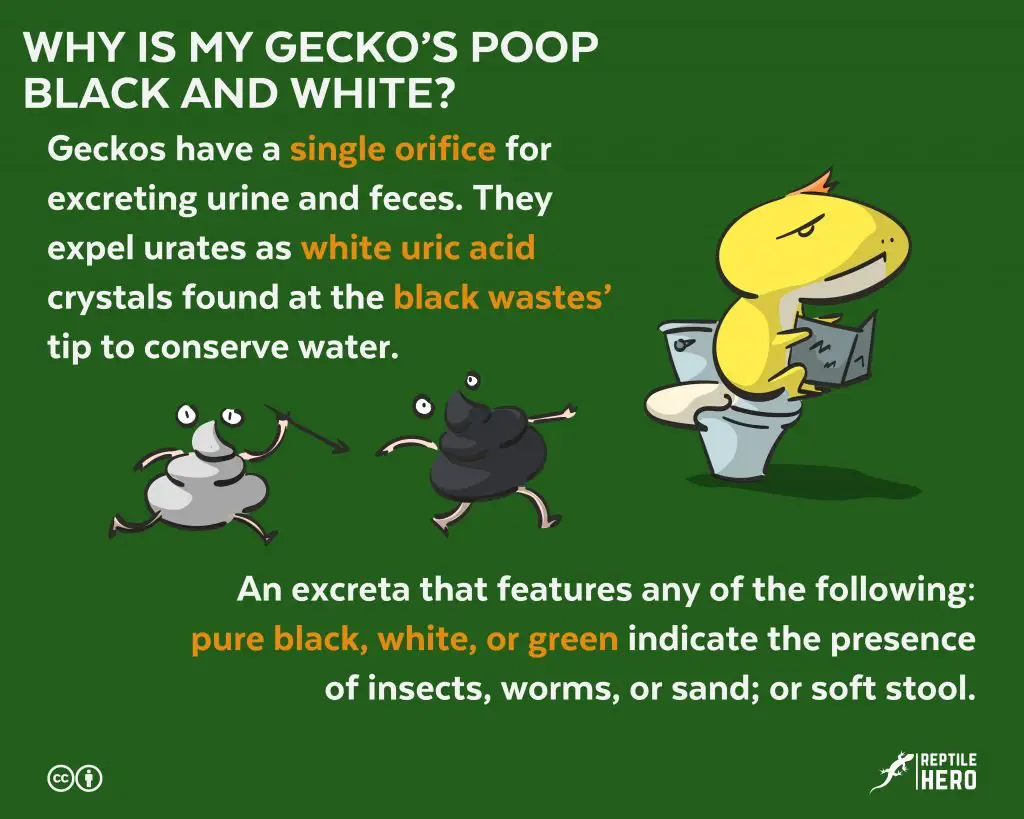
The Conservation of Water: Geckos and Urates
Our glomerulus in the kidneys absorbs roughly 67% of the water that we drink back to the body, while the remaining forms a part of our liquid waste.
On the other hand, geckos’ glomerulus can absorb to the extent of 95% of the water that they drink back to the body, with only the remaining 5% taking part in urates processing.
With the little water left for urates’ disposal, geckos cannot compensate for this by sucking more water as they please to make liquid urine. Unlike how we can quickly drink using our mouths, their anatomy limits them to maximally dip their tongues for a copious refreshment due to lack of larynx.
To make things somewhat inconvenient for the reptile, warm climates in the wild often are scarce in water. As a result, geckos have physiologically evolved their bodies to conserve water and use it most frugally.
These circumstances are the reasons why you do not see many liquid urates in the tank. Unlike us, whose yellowish urine is around 95% water and about 2% toxic urea, geckos excrete their urates in a more efficient form with the little water available for reaction—a concentrated, crystallized white uric acid.
By storing and releasing uric acid as potassium salts, geckos can utilize the little water left for urate excretion. With the approximately same consistency as the stool, this form of urates is less toxic with a lesser need for water to channel it out of the body.
The Path to the Outside World: Geckos and Cloaca
To deal with different bodily wastes, we and our pet cats and dogs have specific body parts to vent out particular excreta. For instance, urine exits the body via the urethra while stool goes out through the body’s anus.
However, unlike us and our pet cats and dogs, geckos have a different way of handling their excrements. In reptile anatomy, geckos have bodies designed of having only a single posterior orifice called cloaca [1]. That is, the cloaca serves as the only opening for digestive, reproductive, and urinary tracts.
In other words, this hole acts as the only passageway for three matters: poop, egg for female geckos, and urine.
Bicolored Droppings: Defecating and Urinating
With the urate’s elimination process prioritizing water conservation and a single orifice for both stool and urine, the resulting excreta passing out of the gecko’s cloaca is a combination of the two: a black sausage-looking roll with a white drop at the tip.
As previously mentioned, the white drop at the tip is the solidified urine in the form of uric acid potassium salts from the gecko’s urinary tract. Meanwhile, the black sausage-looking roll is the fecal matter from its digestive system. It may contain microorganisms from its gut.
However, you should pay attention that you might not only see a hard and well-formed dropping in the tank. Seldom, white or yellowish liquid urine accompanies the white drop at the tip, which is entirely normal. Hence, you should not worry.
Together, the two waste products with or without the liquid urine form the commonly observed unified dropping of a gecko. Usually, its size does not exceed more than one-eighth inch wide and one-fourth inch long.
Here is a short clip of a defecating leopard gecko. Note that the poop has white and black parts.
Factors Affecting Frequency of Excreting Wastes
Depending on the age and the amount of food it has eaten, a gecko may or may not excrete wastes daily. Generally, the more it eats, the more you should observe it eliminates wastes and vice versa.
For a baby up to five months old, you should not worry if it poops a loose stool as much as three times a day. As it eats a lot every day for growth, you should expect defecation just as much.
For a juvenile above five months old, it should release wastes around once a day. Meanwhile, for an adult, you should expect it to poop once every two to three days.
If it was newly bought or recently transferred into a new tank, you should not get worked up if it would not poop as much since your gecko will need ample time to acclimatize and destress for about a week or so.
Otherwise, if you observe anything unusual with your gecko, i.e., it has not defecated for about seven to eight days, there might be something wrong that needs your attention.
7 Signs of An Unusual Gecko Poop
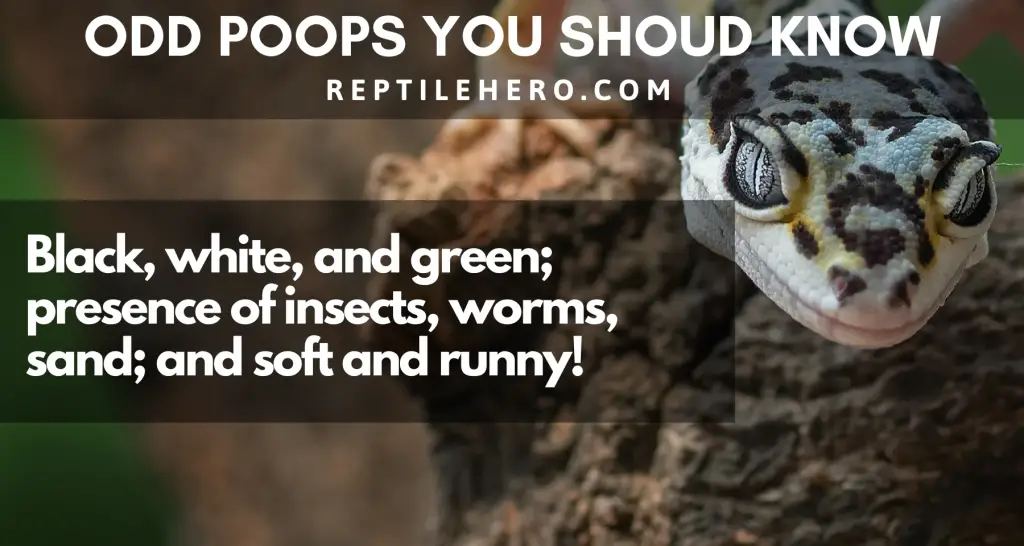
If the thought of having a white drop at the tip of a black sausage-looking roll droppings were not strange enough, you should be more aware if your gecko’s poop does not resemble such features. Frequently, an underlying condition or mishandling issues may cause it to deviate from the usual white-black combination.
Absence of White Tip
You may have been well-acquainted now that the white portion of the poop is analogous to our yellowish liquid urine.
As you have observed in yourself, if you do not drink water regularly, you do not frequently pee in return.
Likewise, the absence of the white tip in your gecko’s droppings simply means it did not have to pee when it defecated.
However, if this persists over a day or two, you must check the relative humidity level in the tank and bowl of water as the lack of the white crystals may already connote dehydration.
Observe then if it will urinate after adjustments.
Purely White Poop
If you have not heeded, your gecko would typically eat the skin it has shed. This situation can result in a white or gray dropping. To remind you, you should not confuse the white urates at the end of the black poop with a purely white poop. They are two different things.
However, if you have a bright substrate with a color close to white or gray, this could also be a reason for the purely white poop. Immediately remove the loose substrate and replace it with firm ones like tiles or paper towels.
If you are not definite whether it is poop or a regurgitated matter, you should monitor your gecko once it has shed its skin.
Ensure it has eaten its skin, and not vomit it! Otherwise, this may pose other signs like low temperature, internal parasites, or digestive issues.
If regurgitation is not related to overeating, it is best to see your exotic veterinarian as soon as possible.
Green Poop
If you have dyed substrates and accessories in the tank, this may cause the green tinge in your gecko’s poop if it has ingested any of those. Otherwise, diarrhea can also cause the stool to have a green hue.
Once the waste matters pass out of the cloaca rather quickly, it could mean the breaking down of bile fluid coming from the gallbladder was not successful. This fluid is still intact with its green color. Thus, the color of the poop. You should seek a veterinarian for proper medication.
Presence of Undigested Insects
Ideally, the poop should be a dark well-formed sausage-like roll with a white tip. However, if you noticed something unfamiliar like an undigested insect, this could mean a few things: impaction, internal parasite, or low tank temperatures.
But first of all, you should make sure that what you have seen is poop and not regurgitated matter. To do so, place your gecko on paper towels and observe its droppings.
Do you observe any substrate in the droppings? In case you have loose substrate in the tank, you must immediately remove it and replace it with a reptile carpet, tiles, or paper towels to prevent impaction.
On the other hand, if it were undigested insects that you see, this could mean that the basking temperature is not warm enough to aid your gecko’s digestion. Make sure to maintain the temperature at 87 to 90°F for optimum digestion.
A more serious reason behind undigested insects in the poop is the presence of internal parasites. These could interfere with your gecko’s appetite resulting in weight loss. You should have its stool undergo a parasite test to dismiss this possibility.
Presence of Worms
The presence of worms in a gecko’s poop may mean two things. The lesser concern of the two would be fly maggots. The larvae may have inoculated if you left the dropping for more than a day. Promptly remove any fecal matter and check if there are still worms.
Another possibility which needs a veterinary visit is a parasitic infection. There are chances that what you have seen are large parasites though most are not visible to the naked eye. As a precaution, have your gecko checked by its veterinarian at once.
Presence of Sand
In the first place, you should not use any sand or loose materials as a substrate for your gecko’s tank. These materials pose a high probability of impaction to baby and juvenile geckos that are more prone to lick things around them.
As a safety measure, you should immediately replace your sand or pebble substrates even if you have not spotted any sand in its poop.
I do not assure you that your loose substrates would successfully pass its digestive tract every time. So, you should not wait to see it happen as impaction has the potential to kill your gecko.
Soft Stool
Unusually, if you observe your gecko’s stool to be soft and runny, this could mean a few things, unlike the well-formed black and white.
The least of the few concerns are changes in diet and supplements. Transitioning from one food to another or switching from one supplement to another could temporarily soften the stool. However, this should resolve by itself after three defecations.
Another reason that needs direct attention is a weakened immune system when your gecko’s gut flora is infected by pathogens—including Cryptosporidium, Entamoeba, and Pinworms. If you observe weight loss, it is likely to be a parasitic infection.
Taking a stool sample for parasite analysis in the veterinary must be conducted to determine the underlying cause.
The Danger of Gecko Poop to Humans
Whatever the features of your gecko’s feces are, these are still unsanitary waste matters that you should treat as a health hazard and clean up accordingly.
Even if they are born in captivity, all reptiles—including your beloved gecko—carry a range of germs, including bacteria, parasites, viruses, and worms. Though its poop is not inherently as lethal as a Komodo dragon’s saliva, you should take utmost care when handling it for disposal. It can carry salmonella, a pathogenic kind of bacteria known to infect people.
With improper handling of the dropping, the bacteria can enter your system via open wounds during contact, nose upon inhalation, or mouth by accidental ingestion.
Most people, though, are strong enough to have an immune system to prevent complications from the infection. The chance of contracting the bacterial infection is slim that even irresponsible owners rarely get infected.
However, if you have weakened immunity like comorbidities, salmonellosis symptoms include diarrhea, headache, fever, stomach cramps, dehydration, and blood poisoning [2].
Immediately seek medical attention if you suffer from any of the severe signs and symptoms upon fecal contact.
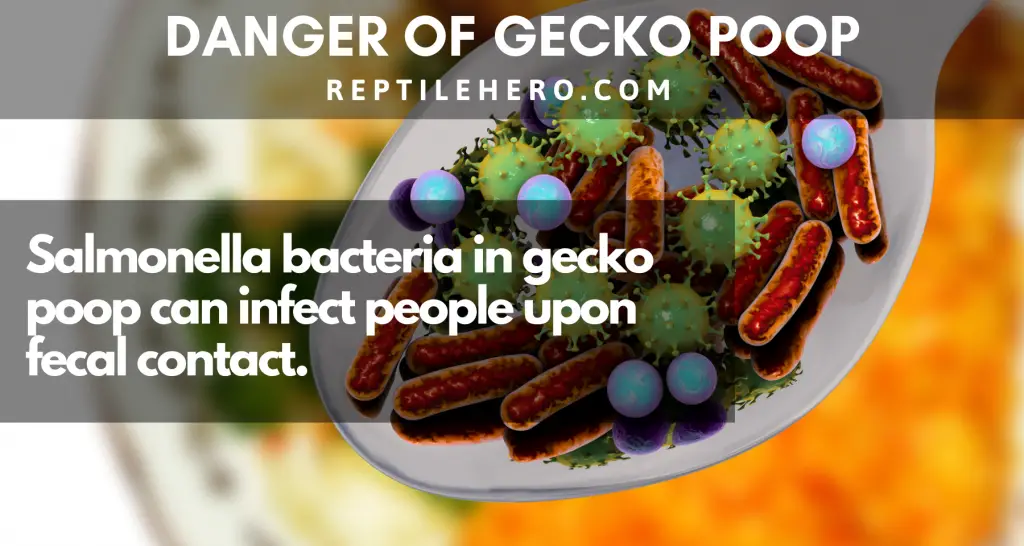
Common Droppings in the Household: Geckos and Pests
If you are a gecko owner and are always dealing with unknown droppings around your house, you might want to read further to know more about the poops of common household pests.
Roof Rats
Roof rats are common household pests that infest several families. If you suspect these pesky creatures in your house, look for dark-colored droppings that have pointed ends. The scattered poops are usually 40 to 50 of these torpedo-shaped matters. Dimensions are commonly three-quarters of an inch long and one-quarter of an inch wide [3].
Mice
As sneaky as their cousin roof rats, mice are notorious pests also common to invade different households. They are common to travel in dark corners and munch over foods at sight. If you feel you live with mice at home, look for small thin pellets roughly three-sixteenth inch long. The dark poops usually have pointed tips and a bulge at the center. Light-colored ones mean it has been excreted in a while [4].
Cockroaches
Though the cousins of household cockroaches, the dubia roaches, are a traditional food for geckos, you should never feed these annoying pests to your reptile. These insects commonly have dark round droppings resembling a coffee bean or ground pepper. However, some also excrete black or brown cylindrical poops [5].
Takeaways
- Geckos must maximize their water utilization; that is why they store and release urates as crystallized salts of uric acid and potassium.
- Like other reptiles, geckos only have a single orifice for excreting both urine and feces. In effect, gecko’s droppings have a white and black part indicating the presence of urine and fecal matter, respectively.
- If the color of the gecko’s poop deviates from the familiar black and white combination, the owner must take notice to determine the underlying cause in the difference of color.
- Common household pests such as roof rats, mice, and cockroaches have distinct fecal matters easily distinguishable from the geckos.
Sources
[1] https://www2.southeastern.edu/Academics/Faculty/dsever/RBPLTChap6.pdf
[3] https://www.pestdetective.org.nz/clues/droppings/separate/#mouse

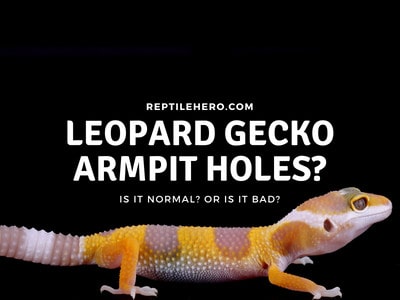
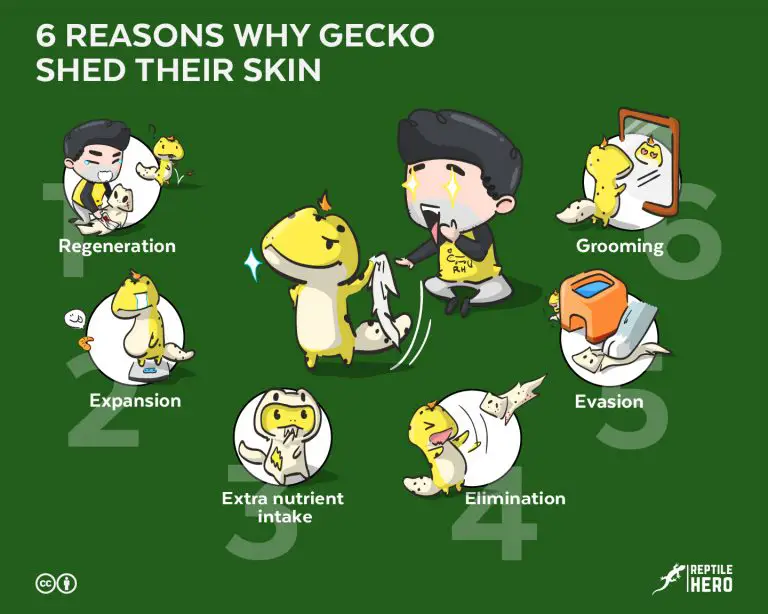
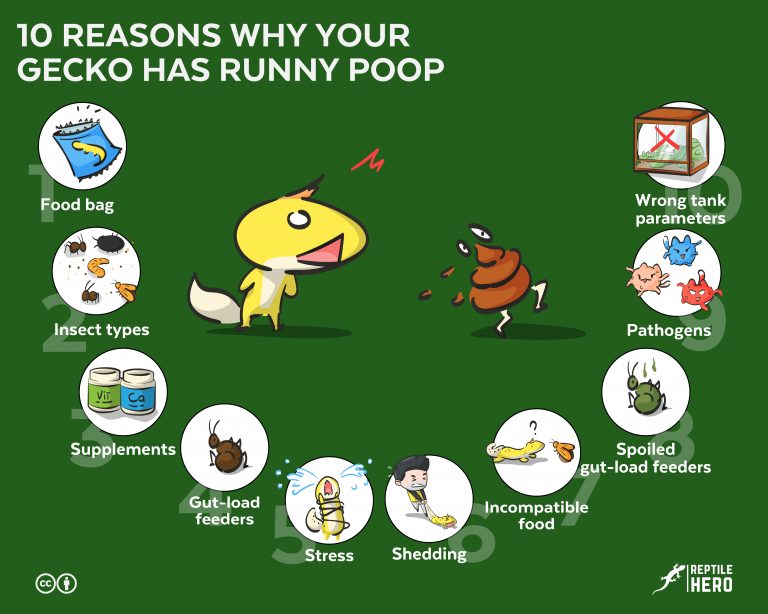
![Why Does Your Gecko Have Red Eyes? [6 Reasons]](https://www.reptilehero.com/wp-content/uploads/2021/03/Why-gecko-red-eyes-reasons-768x614.jpg)
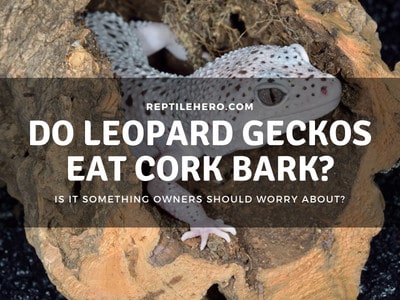
![Why is Your Leopard Gecko’s Nose Red? [9 Causes and Solutions]](https://www.reptilehero.com/wp-content/uploads/2021/10/Red-nose-gecko-cc-768x614.jpg)